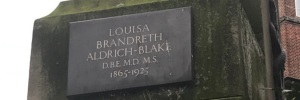The little Old St Pancras church lies to the north of Kings Cross station. Lovely though the church may be it seems an unlikely location for a royal wedding, and indeed it is, but in 1826 a royal wedding of sorts took place there – between Louisa Constance Bouchier Smith and Charles Edward Stuart, Count Roehenstart – pretender to the British throne.
The last of the Stuart monarchs, Queen Anne, died childless in 1714, and the 1701 Act of Settlement prevented Catholics from the throne. This excluded her younger brother James Stuart in favour of Protestant George I. James Stuart, and his son “Bonnie Prince Charlie” made attempts to capture the throne by force, the closest being in 1745 when the rebels reached as far south as Derby, and London went into a state of panic. A further attempt was discussed in 1759 but came to nothing more than plans made in Paris.
By the early 1800s the dreams of restoring the Stuart line were distant indeed. Charles Edward Stuart was the illegitimate son of the illegitimate daughter of Bonnie Prince Charlie had with his mistress. Not the strongest of claims to the throne. Not that this stopped Charles Edward Stuart, given the title Count Roehenstart, claiming to be the rightful ruler. And unlikely as his claim was, in 1817 there was a glimmer of hope for him – none of George III’s children had produced any heirs. This hope ended with the birth of Princess Victoria in 1819 who would go on to be Queen.
Although maintaining his claim to the throne throughout his life (including telling unsubstantiated stories that his parents and grandparents had secretly married), it was more for financial reasons than wanting to be king. Count Roehenstart was victim of a number of financial accidents – he lost most of his fortune investing in a London bank that went bankrupt. After that he became an officer in the Russian army and had planned to marry a Russian heiress, but fell in love with her sister causing a scandal that made him leave for London, minus money he had trusted to a Russian banker. After a fruitless few years trying to chase his lost fortune in America, he returned to London and set to wooing Louisa Constance, who had recently inherited her father’s fortune. She was also cousin of Mrs Fitzherbert, the influential mistress of George IV.
The wedding was a low key affair, although the Count’s friends insisted on titling him Prince Charles at the ceremony. The wedding also took place against the wishes of Louisa Constance’s mother, who seems to have had suspicions that Count Roehenstadt’s was more in love with her daughter’s fortune. Louisa Constance had to write a letter begging her mother’s forgiveness two weeks later. Her mother’s suspicions seem to be well founded, not long after they were married Count Roehenstadt spent time travelling Italy with a woman he claimed to be an aunt. He ignored Louisa Constance’s pleas to be taken on his travels, and he spent much of the following 27 years of their marriage travelling around Europe and America with his “aunt”, while his wife remained in Paris. So not the most auspicious of Royal weddings, but a long lasting marriage, nonetheless.



